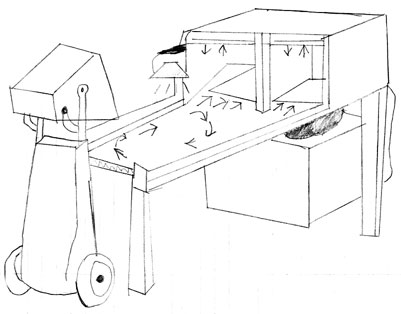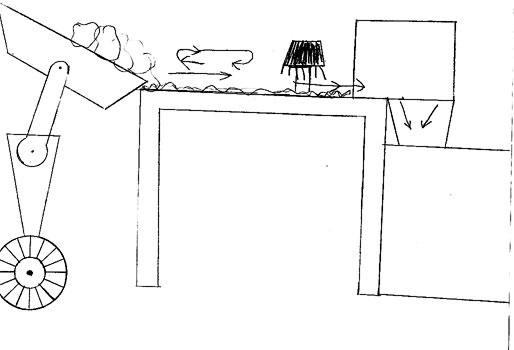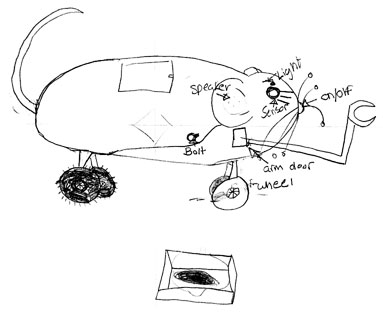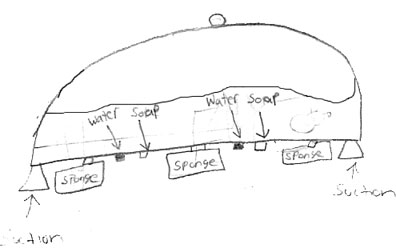|
|
||
| Name: Eliminator
Designer: Daniel Lee Eaglan Jr. Purpose: Eliminate the gross task of picking up dog feces from your yard. |
|
|
Description:
Main seciton: 18" high by 24" long by 12" wide. The main body is constructed out of aluminum sheet metal which is cost effective. The chasis is driven with treads and pulls a small waste receptacle. In the front is a suction tube for removing waste from the ground. Above the tube is a sprayer that coats the waste with a chemical that hardens quickly forming a case around the waste. The hardened waste is easy to remove from the ground and the chemical does not hurt the grass. The tread is made up of two main wheels, one at each end, and seven smaller wheels, three on the top and four on the bottom for stabilization. The waste receptacle also has treads with two large wheels, one on each end, and five smaller wheels, three on the bottom and two on the top for stabilization. The tread runs with standard DC gearmotors that have high torque and are efficient and compact in size. They deliver over 148 inch-pounds of torque to each drive wheel. The robot runs on a rechargable lithium battery located near the bottom of the robot's main section. It is as low as possible for low center of gravity making the robot not tip over easily. When the battery charge gets low the robot returns to a charging station to recharge. Every night the robot returns to the station and plugs itself in to recharge. Heavy gauge wiring is used to minimize loss of power from heating. There is a small on-board computer that holds the programming. The robot runs in a grid pattern searching for the waste to eliminate. There are sensors that you put in the yard to serve as beacons for the robot to know where it is. There is one large sensor that can detect the chemical signature of the animal waste. An additive is put into dog food that makes it easier for the robot to detect the waste. The sensor is positioned on the front under the tube underneath for scanning the area in front of the robot. There is also a sensor array for nagvigation. It is at the front of the robot and sweeps from left to right and stops 25 times to send distance reading to the computer. It uses these reading to navigate and avoid obstables. This sensor transmits ultrasonic sound to meausre the distance by sensing a reflected sound wave. The sound is above human hearing and even dogs cna't hear it. Four more smaller sensors are located on the end of the tube. They are used to position the movable tube directly over the waste and getting the sprayer in position. The waste is picked up and deposited in the receptacle through a small shoot at the back of the main section. It uses a small conveyor belt system to carry the waste in to the recepticle. (see enlarged view on the picture). The waste is processed with chemicals and is turned into fertilizer. The fertilizer is deposited through out the lawn at intervals as needed. The cost of the eliminator is $300. It runs on a small inexpensive motor and has a case made from hard plastic and metal. The small on-board computer is based on the inexpensive flash drives that are available today for around $100 for 1G of hard disk space. The rechargable lithium battery runs about $50. The small size keeps the cost down and the repairs inexpensive. |
Problems: |
|
This idea seemed very simple in the beginning. It was just a robot with an arm that could scoop up the dog waste and throw it into a basket. But we told the idea to a teacher to get feed back and the teacher brought up some interesting problems with the design. First, how would the robot know where the dog waste was? Was the robot going to pick up new waste that would be soft or old waste that would be hard? Would the scooping action of the robot harm the lawn? With these problems in mind, the robot was redesigned to include the addition of sensors that could detect the waste, the chemical spray to make the waste hard for easy pick up, and the vacuum suction to remove the waste from the ground without harming the grass. There are still problems with the design. It would need a very sophisticated software program to be able to accomplish its tasks autonomously. It would have to be popular enough to get the dog food manufacturers to add something to dog food. Another solution would be for the owner to put in the additive, but it would be better if they didn't have to worry about that. |
 |
 |
Name: Wash - No - MoreDesginer: Kyle GundlachPupose: Gather, sort, wash, and dry laundry.Description:All you have to do is throw your dirty laundry into the carbot bin. When the bin reaches a certain weight, (a sensor in the bottom of the bin measures the weight) the carbot then returns to the main sorter/washer/dryer bot. The carbot dumps the clothes on a conveyer nelt. The belt rotates automactically when the sensors are activated by the weight of the clothes. The carbot must be in place at the edge of the sorter for it to operate for safety. The belt rotates teh clothes around under a sensor that can detect a small microchip that is in each of the clothes. It is based on the RFID tag which is a microchip combined with an antenna in a small package. They can be as small as a grain of rice. The chip contains information that the carbot can read about the clothes including the material it is made of and the proper washing and drying procedure for that piece of clothing. The microchip is in a small filiment woven into the clothes like thread. If the sensor for light clothes is detected then a second conveyor belt moves that pulls the clothes into the light bin. If the sensor for dark clothes is detected then the first conveyor belt moves on and then the clothes are pulled into the dark bin by a third converyor belt. When one of the storage bins reaches the appropriate weight then the bin bottom opens and the clothes empty into a chute that empties into a wahsing/drying machine. Once washed and dried the clothes are then emptied into a pickup bin. the side of the washer/dryer folds down and the clothes are pushed off into the bin. The carbot is signaled by a sensor in the pickup bin and the carbot sends an email to the main house computer to have the clothes picked up. The cost of the Wash-No-More is $900. This is comparable to a laundry system on the market today. The washer and dryer are similar to today's machines and cost about the same. The carbot uses an inexpensive computer and is made of hard plastic. It balances using sonar sensors and its cost is about $200. The conveyor belt system and the sensors are comparably inexpensive. Problems:There are a couple of problems with the design of the Wash-No-More. One is that it could get jammed. There would have to be some kind of sensor system to keep this from happening. Two, there could be some obstacels that get in the way of the dirty clothes bin. Also, the carbot would have to navigate around in your house. A lot of peoples' houses ar different and have stuff lying around which makes it difficult for the robot to navigate. This is a big problem that will have to be solved in the software code. The smarter the robot is then the better it will be at its job. But software that can control a robot like this would be expensive to develop. There would have to be a great market for this kind of household robot to be practical to develop. Perhaps the kind of software that would be needed for a truly intelligent household robot will be developed and then inventors and manufacturers can make application of it and use it in their designs without having to spend the large amount of money to develp it themselves. |
 |
 |
 |
Litterbox MouseThis cute little robot is desgined to clean out the smelly litterbox in your house. It is 10 inches by 5 inches and weighs less than 16 ounces. It can strain the litter with an arm attachment and place the cat waste on a plastic bag, seal it, and deposit it in the waste receptacle.It is an inexpensive way to keep your litterbox clean and smelling fresh. It ooperates on a small rechargable battery and a usb port for downloading the programs. It costs $99. |
FetcherThis robot is called Fetcher. Fetcher fetches things for you. All you have to do is to click a button and point a laser at the object and Fetcher will get it. It can tell how big the object is and where it is at from sensors that pick up the reflected laser light. Height – 2ft Weight – 30lb Width – 3ft Ability – to stretch it’s claw and drive on it’s back. Waterproof up to a depth of 30ft. Fireproof up to 2700 F. Made of metal. |
Scrub-AwayA small robot that works with other robots to clean your tub, sink, or mirrors. It holds itself in place on the surface with suction and dispenses cleaning fluiding and water to clean the surface. Scrub-aways are very small and you get four of them so that they can work as a team to get the job done.Each robot is about the size of your hand and the set of four only costs around $80. You program in the size of your tub and sink and mirrors and then download the info to Scrub-Away. |

